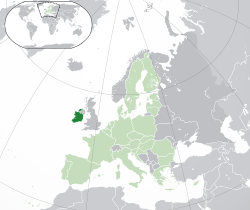
Back Ирландиа Abkhazian Irlandia ACE Ирландие ADY Republiek Ierland Afrikaans Irland ALS አየርላንድ ሪፐብሊክ Amharic Irlanda AN Irland seo Cynewise ANG جمهورية أيرلندا Arabic ܩܘܛܢܝܘܬܐ ܕܐܝܪܠܢܕ ARC
Ireland[a] Éire (Irish) | |
|---|---|
| Anthem: "Amhrán na bhFiann" (English: "The Soldiers' Song") | |
 Location of Ireland (dark green) – on the European continent (green & dark grey) | |
| Capital and largest city | Dublin 53°20.65′N 6°16.05′W / 53.34417°N 6.26750°W53°N 8°W / 53°N 8°W |
| Official languages | |
| Ethnic groups (2016[2]) |
|
| Religion (2016) |
|
| Demonym(s) | Irish |
| Government | Unitary parliamentary republic |
| Michael D. Higgins | |
| Simon Harris | |
• Tánaiste | Micheál Martin |
| Frank Clarke | |
| Legislature | Oireachtas |
| Seanad | |
| Dáil | |
| Stages of independence from the United Kingdom | |
| 24 April 1916 | |
| 21 January 1919 | |
| 6 December 1921 | |
| 6 December 1922 | |
| 29 December 1937 | |
| 18 April 1949 | |
| Area | |
• Total | 70,273 km2 (27,133 sq mi) (118th) |
• Water (%) | 2.00 |
| Population | |
• 2020 estimate | |
• Density | 70.8/km2 (183.4/sq mi) (113th) |
| GDP (PPP) | 2019 estimate |
• Total | |
• Per capita | |
| GDP (nominal) | 2019 estimate |
• Total | |
• Per capita | |
| Gini (2018) | low · 23rd |
| HDI (2018) | very high · 3rd |
| Currency | Euro (€)[note 1] (EUR) |
| Time zone | UTC (GMT) |
• Summer (DST) | UTC+1 (IST) |
| Date format | dd/mm/yyyy |
| Driving side | left |
| Calling code | +353 |
| ISO 3166 code | IE |
| Internet TLD | .ie[c] |
| |
Ireland (Irish: Éire [ˈeːɾʲə] (![]() listen)) is a European country on the island of Ireland. It shares a border with Northern Ireland (which is controlled by the United Kingdom). The country is sometimes called the Republic of Ireland to distinguish it from the island.
listen)) is a European country on the island of Ireland. It shares a border with Northern Ireland (which is controlled by the United Kingdom). The country is sometimes called the Republic of Ireland to distinguish it from the island.
It is a member of the European Union. The republic's capital is Dublin. Cork is the second largest city in the country and the third largest on the island of Ireland. The population of Ireland is 4.9 million. English is the main language spoken. The Irish language is widely taught in all schools, and it is still spoken as a first language in some areas of the country, known as the Gaeltacht. Irish is the first official language, followed by English.
- ↑ "Official Languages Act 2003". Office of the Attorney-General. Retrieved 18 February 2012.
- ↑ "CSO Census 2016 Chapter 6 – Ethnicity and Irish Travellers" (PDF). Retrieved 28 April 2017.
- ↑ "Population and migration estimates April 2020". 22 August 2020.
- ↑ 4.0 4.1 4.2 4.3 "World Economic Outlook Database, October 2019". IMF.org. International Monetary Fund. Retrieved 8 January 2020.
- ↑ "Gini coefficient of equivalised disposable income – EU-SILC survey". ec.europa.eu. Eurostat. Retrieved 8 January 2020.
- ↑ "Human Development Report 2019". United Nations Development Programme. 10 December 2019. Archived from the original (PDF) on 30 April 2020. Retrieved 10 December 2019.
- ↑ Coakley, John (20 August 2009). Politics in the Republic of Ireland. Taylor & Francis. p. 76. ISBN 978-0-415-47672-0. Retrieved 2 May 2011.
<ref group=note> tags on this page, but the references will not show without a {{reflist|group=note}} template (see the help page).

